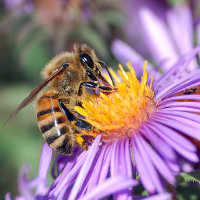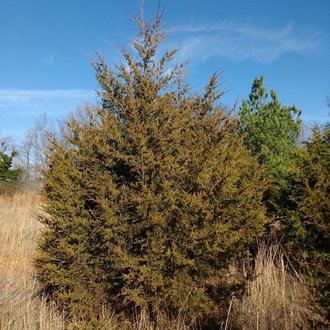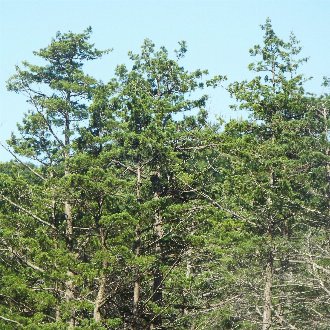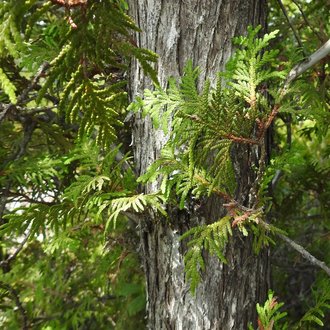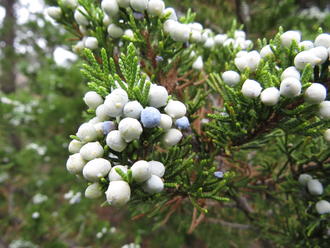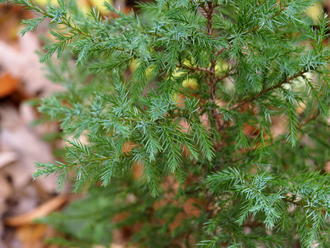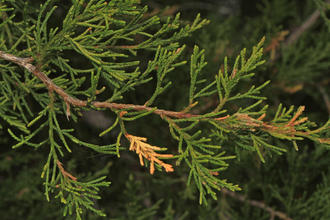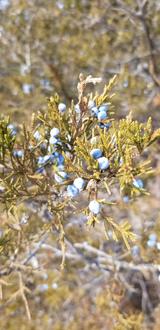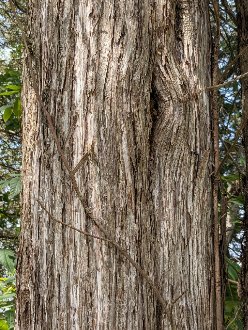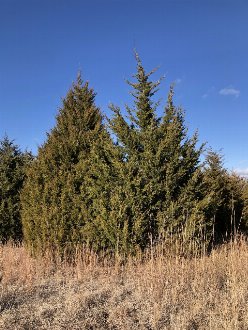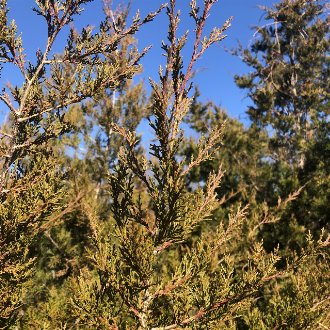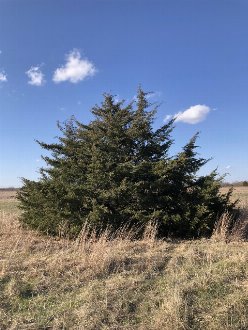Eastern Redcedar (Juniperus virginiana L.)
Also known as eastern red-cedar, eastern red cedar.
↑Summary
A native evergreen conifer of sunny habitats; unlike most conifers, tends to decrease soil acidity.
↑Range - Expand
| Legend | Color |
| Native | |
| Native or Not Present | |
| Introduced or Not Present | |
| Native or Expanded |
This tentative map is based on our own research. It may have limited data on Canada and/or Mexico, and there is some subjectivity in our assignment of plants as introduced vs. expanded. Read more in this blog post.
Although this plant occurs somewhere in each of these regions, it may only occur in a small part of some or all of them.
↑Similar Plants
↑Habitat
Eastern redcedar is found on a variety of sunny sites not subjected to fire, and prefers drier sites. In more humid climates, it is a pioneer species of disturbed ground, where it only occupies early successional stages. Throughout its range it also occurs as a more permanent tree of more barren, exposed sites. Natural habitats include thin upland woods, limestone barrens, rock outcroppings, and sand dunes. It also occurs in anthropogenic habitats including woodland edges, areas along roadsides and railroads, and abandoned fields.
It can colonize prairies and savannas if fire is suppressed, and is generally seen as a threat to these communities because they are not adapted to its presence.
Eastern redcedar prefers full sun and exposed conditions, and is usually found in nutrient-poor soil where there is less competition from other plants, but it benefits from high calcium content in soil. It is usually much more abundant in the early successional communities on soils derived from limestone, dolomite, and other calcium-rich substrates. It tolerates and even prefers gravel, clay, sand, rocky, and alkaline soils. It tolerates wetter conditions but usually faces more competition from other species in wetter environments. It is salt tolerant, and can found in brackish marshes, dunes subject to salt spray, and barrier islands subject to occasional saltwater flooding.
It is intolerant of fire and is absent from habitats subjected to fire, except for temporarily occurring during years where there is consistent moisture.
Humans have massively increased the habitat for this species through agriculture, building of roads and railroads, clearing of forests and degradation of soils, and in the drier regions where it occurs, through fire suppression.
↑Life Cycle
Plants sprout from seed and quickly establish a deep taproot, which is followed by extensive, shallow roots. On rocky sites with shallow soil, the taproot grows horizontally. Initial growth is invested mostly in the root system and show little above-ground growth during their first year. Seedlings are intolerant of shade and require extensive direct sunlight; they also tend to do better on sites with less leaf litter.
Trees begin flowering and producing seed at about 10 years of age, with production peaking between 25 and 75 years. Female and male flowers are borne on separate plants, and in one study the ratio of male to female plants tends to range from 1:1 on some sites to 2.2:1 on others. Flowers are wind-pollinated. Seeds are borne in a berry-like, fleshy cone that is commonly referred to as a "berry". Seeds mature in winter, and are primarily distributed by wintering birds which eat the fruit during a time of year when other food sources are scarce. Seedlings tend to concentrate in areas near suitable perches for fruit-eating birds.
Established trees are tolerant of some shade from other plants, but trees of any age are intolerant of heavy shade and will die under a closed forest canopy. Can live as long as 450 years on more exposed sites, but often creates conditions that result in its own elimination from the ecosystem in a much shorter time-frame, as it is replaced by more shade-tolerant tree species that eventually shade it out.
The leaf litter from this species is very high in calcium, which tends to increase the soil pH. On many sites, with naturally acidic soils and calcium being a limiting factor in plant growth, over time this favors other more shade-tolerant vegetation.
↑Faunal Associations
Berries are eaten by birds, mostly overwintering birds in winter and early spring. Hosts cedar-apple rust.
↑Control
In most of its range, Eastern Redcedar is beneficial, and is part of the natural succession trajectory on disturbed sites, and will naturally replaced by other vegetation. However, in the more drier portions of its range, it can be a problem when it moves into drier, fire-prone habitats with deep soils. In these areas it can be a particular threat to fire-tolerant trees such as oaks, as its presence can inhibit regular ground fires, allowing for more litter accumulation and then providing a fire ladder that can lead to a severe, crown-destroying fire in a dry year.
Regular (annual) controlled burns are usually effective at preventing Eastern Redcedar from colonizing these habitats. However, if a site has not burned recently, and redcedars have reached considerable size, fire is likely to be either ineffective or dangerous: in normal conditions, mature redcedar will exclude fire, but under dry conditions the entire tree could ignite, posing risk of more severe fire that becomes out-of-control.
Herbicide is sometimes used to control redcedar but we recommend against this approach; because of its lower leaf surface area and waxy coating on the leaves, redcedar will resist herbicides unless high amounts of herbicide and surfactants are used. The most commonly used herbicides for redcedar are hexazinone (in Velpar) and picloram (in Tordon 22K or Surmount). Picloram tends not to affect grasses much, but it persists long-term in the environment and can harm non-target vegetation months or even years after it is applied. Hexazinone does not persist as long in the environment, but is more damaging to grasses, and grasses tend to be the plants most in need of protection in areas redcedar is invading.
Mature redcedars are usually easy to kill by cutting them to the ground, as they cannot resprout if they are cut beneath their lowest limb. The wood and dried foliage are highly flammable and can cause fires to increase in severity, so it is best to remove the material rather than leave it in place. If there is concern about removing too many mineral nutrients from the ecosystem, they can be burned in a controlled environment and the ashes returned to the site.
↑Uses
The wood of this species is aromatic and rot-resistant. It has moth-repellant properties, and as such is often used for constructing chests or closets in which to store clothing.
It is sometimes used as a landscaping plant, especially as a windbreak where it is valued for its robustness on exposed sites. Several cultivars exist. It has some undesireable features as a landscaping plant, including sharp, prickly foliage, poor shade tolerance, which can lead to unattractive, unhealthy trees on shaded sites, and the fact that it hosts cedar-apple rust, which harms apple trees and is particularly damaging to commercial apple orchards.
↑Related Plants
There are numerous other Juniperus species in North America, almost all native except for three introduced species that have become introduced in a few isolated areas. In most of this species' range, it is the only member of its genus, but it overlaps with numerous other species at the north and west borders of its range.
In the north and the extreme west of its range, it overlaps widely with common juniper (Juniperus communis). In the extreme north of its range, it also overlaps with creeping juniper (Juniperus horizontalis). Both of these are primarily mat-forming plants, but common juniper can sometimes also grow upright like a tree.
At the west of this species range, it also overlaps with rocky mountain juniper (Juniperus scopulorum), and in the southwest, with Pinchot's juniper (Juniperus pinchotii) and oneseed juniper (Juniperus monosperma). There is also significant overlap with Ashe's juniper (Juniperus ashei) from Arkansas west into Oklahoma and barely south into Texas.
The broader Cupressoideae subfamily of the Cupressaceae (Cypress) family contains numerous other genera. Of them, two overlap with this one in range: northern white-cedar (Thuja occidentalis) in the north and in the Appalachians, and atlantic white cedar (Chamaecyparis thyoides) along the Atlantic coast.
↑Notes
Contrasting with most coniferous trees, whose leaf litter makes the soil more acidic, the litter of the eastern redcedar tends to make the soil more alkaline due to being high in calcium.
↑Links & External Resources
• Aromatic Red Cedar | The Wood Database (About This Site)
• Eastern Redcedar | Fire Effects Information System (FEIS) (About This Site)
• Juniperus virginiana (Eastern Red Cedar) | Illinois Wildflowers (About This Site)
• Juniperus virginiana (Eastern Redcedar) | USDA PLANTS Database (About This Site)
• Juniperus virginiana | Go Botany (About This Site)
• Juniperus virginiana (Red Cedar) | Missouri Botanical Garden Plant Finder (About This Site)
• Eastern Redcedar | Virginia Tech Dendrology Factsheets (About This Site)
• Eastern Redcedar | Silvics of North America (About This Site)
• Juniperus virginiana | Biota of North America Project (BONAP) (About This Site)
• Juniperus virginiana | NatureServe Explorer (About This Site)
• Juniperus virginiana | Flora of North America (About This Site)
• Eastern Red Cedar | Maryland Biodiversity Project (About This Site)
• Juniperus virginiana L. var. virginiana (Eastern Redcedar) | Digital Atlas of the Virginia Flora (About This Site)

